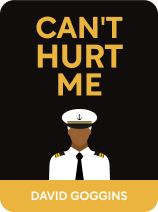

This article is an excerpt from the Shortform book guide to "Can't Hurt Me" by David Goggins. Shortform has the world's best summaries and analyses of books you should be reading.
Like this article? Sign up for a free trial here .
What is David Goggins’ cookie jar theory? How does this strategy work and how did Goggins use it?
David Goggins’ cookie jar idea is that reminding yourself of your accomplishments makes you more likely to tackle obstacles. It helps build confidence and allows you to be honest with yourself.
Read more about David Goggins’ cookie jar strategy.
David Goggins’ Cookie Jar
We often decide to take on challenges while we’re in our comfort zone, but we’re so comfortable, we don’t anticipate obstacles that could arise. To deal with this, we need additional strategies to keep going, even when we face obstacles and want to quit.
Reminding yourself of your previous accomplishments is one way to overcome obstacles. Goggins calls this collection of accomplishments your Cookie Jar. Here’s what David Goggins’ cookie jar strategy is all about:
There’s science behind this strategy. If you get overwhelmed by obstacles, you may forget why you’re doing something and start talking to yourself in a negative way that robs you of energy to keep going. When you feel stressed, your body’s fight or flight system is at work. It’s trying to make a decision about whether to continue with what you’re doing (fight) or abandon it (flight). Focusing on your accomplishments instead of doubtful negative self-talk reminds you of what you’re capable of, giving you the energy to “fight” and keep going.
Goggins developed the cookie jar concept during his experience transitioning from Navy SEAL to ultramarathon runner.
Digging Into the Cookie Jar
Despite desperately wanting to quit, Goggins drew upon yet another strategy to keep going—his Cookie Jar. Growing up, Goggins’s mother always made sure to stock their cookie jar with a variety of cookies. She’d let him have two at a time, and he learned to savor each cookie. David Goggins’ cookie jar brought a little brightness to both of their lives.
He applied this as a metaphor to help himself get through tough times—he drew from a mental cookie jar of his accomplishments when times were tough. In this way, he used his past victories to motivate himself to keep going. David Goggins’s cookie jar included cookies like studying to bring himself up to the appropriate reading level, passing the Air Force exam, and losing 106 pounds in three months to be eligible for SEAL training. This strategy is more than just thinking about the memory—it’s remembering how good it felt in the moment.
Thinking about his past victories and recognizing his toughness gave Goggins strength to start running again and finish the race. Though he suffered severe dehydration, he felt elated to be able to finish the hundred miles.
Take Action: Stock Your Cookie Jar
Now that you know about David Goggins’ cookie jar strategy, you can come up with your own set of victories to remind yourself of when facing difficulty. Here’s how:
- Use your journal to write down your major life victories. Examples include exceeding a sales goal, running a half marathon, or convincing the city council to fund homelessness services.
- Write down all of the obstacles you’ve overcome, too. Examples include managing obsessive compulsive disorder, stopping smoking, or improving your relationship with your parents.
- As you work toward your goals, draw on this list to help you when you want to stop short of your goal.
- (Optional) Share your cookies and how they help you reach new goals through social media with the hashtags #cookiejar #canthurtme

———End of Preview———
Like what you just read? Read the rest of the world's best book summary and analysis of David Goggins's "Can't Hurt Me" at Shortform .
Here's what you'll find in our full Can't Hurt Me summary :
- What a Navy SEAL says about pushing yourself to achieve greatness
- How to put in more effort to realize your potential
- The 10 challenges you can take on to reach your goals






